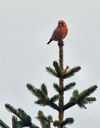Genus Loxia
American Crossbill - This crossbill is mainly resident, but will regularly irrupt south if its food source fails. This species will form flocks outside the breeding season, often mixed with other crossbills.
Two-barred Crossbill - This bird breeds in the coniferous forests of Alaska, Canada, northernmost USA and across Asia extending into northeast Europe. It nests in conifers, laying 3-5 eggs.
Hispaniolan crossbill - It was formerly regarded as conspecific with the Two-barred Crossbill , from which it is now assumed it evolved.
Parrot Crossbill - This bird breeds in the pine forests of northwest Europe and into western Russia. There is also a small population in Scotland, adding to the difficulty of distinguishing it from Common Crossbill and the endemic Scottish Crossbill, both of which breed within its range.
Scottish Crossbill - The British Ornithologists Union first classed the Scottish Crossbill as a separate and distinct species in 1980, but some ornithologists believed there was insufficient scientific research for its status. It was considered to be possibly a race of either the Common Crossbill or the Parrot Crossbill, both of which also occur in the Caledonian Forest.



